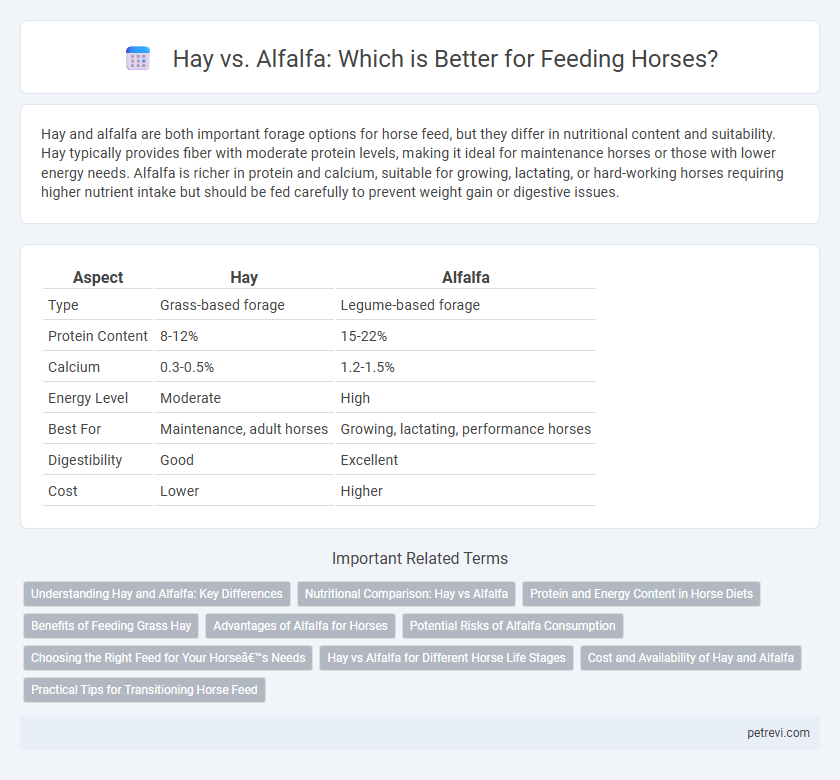Hay and alfalfa are both important forage options for horse feed, but they differ in nutritional content and suitability. Hay typically provides fiber with moderate protein levels, making it ideal for maintenance horses or those with lower energy needs. Alfalfa is richer in protein and calcium, suitable for growing, lactating, or hard-working horses requiring higher nutrient intake but should be fed carefully to prevent weight gain or digestive issues.
Table of Comparison
| Aspect | Hay | Alfalfa |
|---|---|---|
| Type | Grass-based forage | Legume-based forage |
| Protein Content | 8-12% | 15-22% |
| Calcium | 0.3-0.5% | 1.2-1.5% |
| Energy Level | Moderate | High |
| Best For | Maintenance, adult horses | Growing, lactating, performance horses |
| Digestibility | Good | Excellent |
| Cost | Lower | Higher |
Understanding Hay and Alfalfa: Key Differences
Hay and alfalfa are essential horse feeds with distinct nutritional profiles; hay is primarily grass-based, offering moderate fiber and energy, while alfalfa is a legume rich in protein and calcium. Horses requiring higher protein for growth, lactation, or intense work benefit more from alfalfa, whereas mature horses with lower energy needs thrive on grass hay. Understanding these differences helps optimize equine diets for health, digestion, and performance outcomes.
Nutritional Comparison: Hay vs Alfalfa
Hay typically contains higher fiber and lower protein levels, making it ideal for maintenance diets in horses, while alfalfa is rich in protein, calcium, and energy, suitable for active or growing horses. The calcium content in alfalfa is approximately three times that of grass hay, which supports bone development but may require balancing with other feed to avoid nutritional imbalances. Alfalfa's nutrient density promotes muscle growth and recovery, whereas hay's higher fiber aids in digestion and gut health for horses with lower energy demands.
Protein and Energy Content in Horse Diets
Alfalfa hay contains higher protein levels, typically ranging from 15% to 20%, making it ideal for growing, lactating, or performance horses requiring additional protein. In contrast, grass hay generally offers lower protein content, around 8% to 12%, suitable for maintenance diets with moderate energy needs. Alfalfa also provides more digestible energy due to its higher calorie density, supporting horses with increased workload or recovery requirements.
Benefits of Feeding Grass Hay
Grass hay offers a natural fiber source essential for maintaining healthy digestion in horses, promoting steady chewing and saliva production which aids in preventing colic. Rich in nutrients like digestible fiber, vitamins A and E, and moderate protein levels, grass hay supports overall equine health without the excessive calcium and protein found in alfalfa. Feeding grass hay helps maintain optimal body condition and provides a balanced energy supply ideal for horses with moderate work demands or weight management needs.
Advantages of Alfalfa for Horses
Alfalfa offers superior protein, calcium, and energy content compared to typical hay, promoting muscle development and bone strength in horses. Its higher digestibility supports improved nutrient absorption, aiding performance and recovery for active or growing horses. The natural palatability of alfalfa encourages better feed intake, reducing the risk of digestive issues.
Potential Risks of Alfalfa Consumption
Alfalfa hay, while nutrient-rich, poses potential risks for horses due to its high protein and calcium content, which can lead to digestive upset and increase the likelihood of kidney stress or bladder stones. Its rich energy profile may cause weight gain or laminitis in horses prone to metabolic disorders. Careful monitoring and balancing with other forages like grass hay is essential to mitigate these risks and maintain equine health.
Choosing the Right Feed for Your Horse’s Needs
Choosing the right feed for your horse's nutritional needs depends on factors such as age, workload, and health conditions. Hay, typically grass-based, provides essential fiber and is suitable for most horses requiring maintenance energy, while alfalfa offers higher protein and calcium levels, making it ideal for growing, lactating, or performance horses. Balancing these feed types with proper forage analysis ensures optimal digestion and supports overall equine health.
Hay vs Alfalfa for Different Horse Life Stages
Alfalfa provides higher protein and calcium levels, making it ideal for growing foals, lactating mares, and performance horses requiring increased nutrients. Grass hay, with lower energy and protein content, suits maintenance horses, older horses, and those prone to obesity or metabolic issues. Selecting hay or alfalfa depends on the horse's life stage, workload, and specific nutritional demands for optimal health and performance.
Cost and Availability of Hay and Alfalfa
Hay generally costs less than alfalfa due to its higher availability and widespread cultivation, making it a budget-friendly option for horse owners. Alfalfa, rich in protein and calcium, tends to be pricier and less abundant, especially in regions with limited growing seasons for legumes. Assessing local market trends and seasonal supply can help optimize costs when choosing between hay and alfalfa for equine nutrition.
Practical Tips for Transitioning Horse Feed
When transitioning a horse from hay to alfalfa, gradually introduce the new feed over 7-10 days to minimize digestive upset. Monitor the horse for signs of colic or diarrhea, adjusting portion sizes if needed to allow the gut microbiome to adapt. Ensure plenty of fresh water is available to support digestion and prevent dehydration during the dietary change.
Hay vs Alfalfa for Horse Feed Infographic

 petrevi.com
petrevi.com